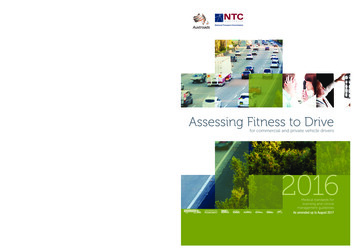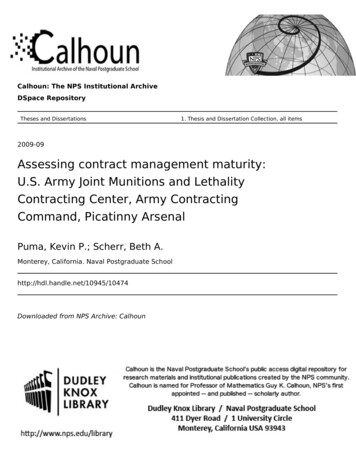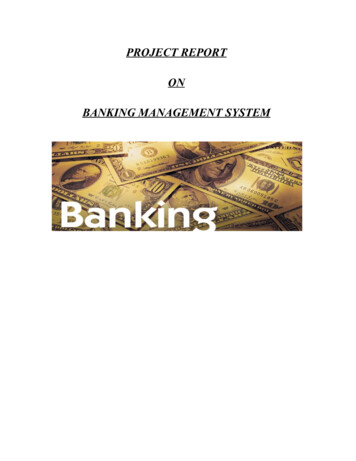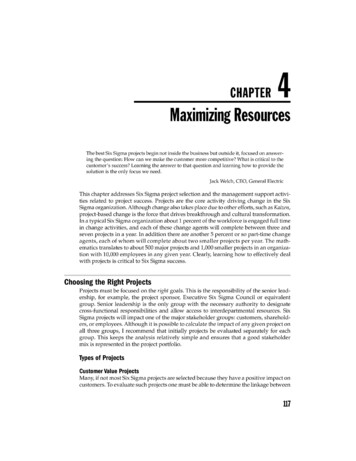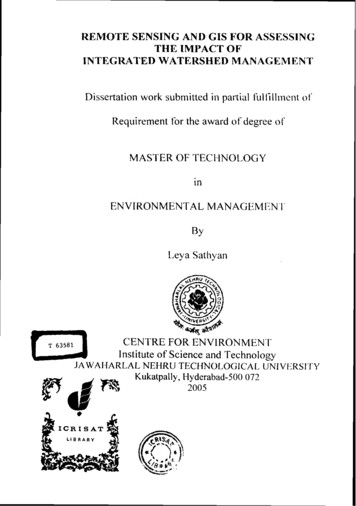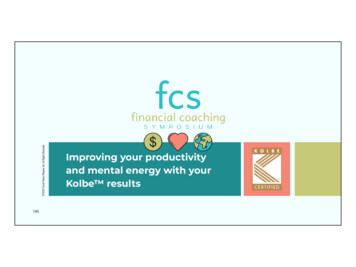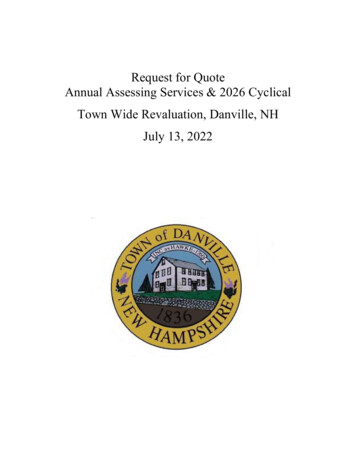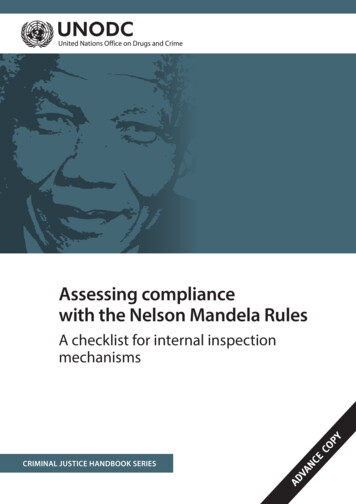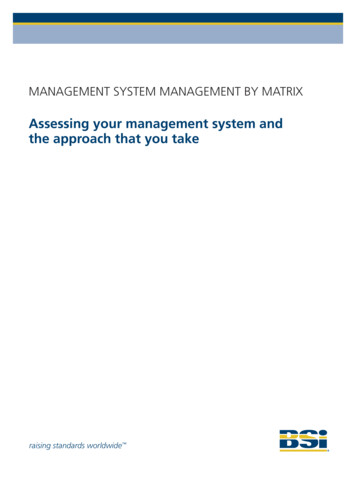
Transcription
Management system management by matrixAssessing your management system andthe approach that you takeraising standards worldwide 16448 Management Systems Matrix 1 113/4/10 15:23:18
About the authorJohn Osborne is Product Manager for BSI Training. The following content is based on his observations over the 10 years ofinvolvement with management systems both as a trainer and business development manager.In the article John addresses areas of concern experienced by many management system professionals, and converts theminto a series of matrices with guidance on how to change and improve as required or desired. Although primarily focusedon quality management systems, many of the matrices are valid for all types of management system which comply withthe requirements of a particular standard or industry scheme.After each matrix there is a list of possible actions to be taken. In most cases an organisation will have a situation thatdoes not fall exactly in one of the four boxes. However, it is hoped that the commentary will still provide some usefulideas and that by going through the process management system professionals will be able to use the matrix to help setgoals and plans.This white paper can also be downloaded at www.bsigroup.co.uk/matrices and John can be contacted at:john.osborne@bsigroup.com Management System Management by Matrix16448 Management Systems Matrix 2 213/4/10 15:23:18
Is your business engaged with the system?Matrix 1 begins by addressing a familiar complaint from system managers, that of engagement with the system.Business Engagement With The System?Staff EngagementHighLow1) Well done2) Avoid loss of interest3) Opportunity4) ChallengingHighManagementEngagementLowMatrix 11. Well done: keep going but ensure that you communicate with both groups on a regular basis and celebrate success.2. Avoid loss of interest: if enthusiasm from the top is not being matched, they could lose interest. Understand the reasonwhy staff are not engaged, perhaps by implementing a survey. Consider the introduction of improved processes,procedures and work instructions or a new approach to auditing which would change the situation. You may alsolike to look at the competencies staff require and taking action to address any areas where those competencies needimproving. Simply improving communication about the purpose of the system may also help.3. Opportunity: use the enthusiasm of staff to identify some quick wins and then make sure that management is broughtinto these and understands how they were achieved.4. You have a challenge: try and understand the reasons with both groups. Take advantage of a critical business issue, forexample the high cost of quality, to engage with senior managers and gain their support. Maybe use your certificationbody to help with internal communication or briefing.Management System Management by Matrix16448 Management Systems Matrix 3 3 13/4/10 15:23:18
So why do you have a management system?In the introduction to ISO 9001, it states that the decision to introduce a quality management system is a strategicdecision which should be taken by the senior management of the business. Once taken and certification achieved, this isoften forgotten. The matrices below may help you to keep this thought alive and enable you to identify how the systemcan contribute to the competitive environment that you are in.Matrix 2 identifies typical drivers for implementing a management system.Business Drivers For The Management SystemExternal DriversHighLow1) Investment2) Business improvement3) Cost4) Why do it?HighInternalReasonsLowMatrix 21. Investment: achieving satisfied stakeholders and delivering internal changes that benefit the business is obviously thebest way to achieve return on the investment being made. Many clients have reported significant improvements bysimply improving communication between teams.2. Business improvement: in this situation organisations use the framework to assist with improving their processes toeither reduce costs or improve customer satisfaction. A mature approach to process management can be a majorbenefit in achieving this.3. Cost: experience shows that when organisations only implement for an external reason such as customer demandwithout appreciating the internal benefits that can be achieved, it becomes a business cost rather than a business toolthat can drive change and improvement.4. Why do it? With no internal or external drivers it is likely that the project will fail through lack of support. If it goesforward it may be useful to try and find a driver that people can buy into. For instance the loss of a major customer ora significant complaint. Management System Management by Matrix16448 Management Systems Matrix 4 413/4/10 15:23:19
What is the purpose of your system – compliance or improvement?This is often an area where major changes in perception and benefit can be achieved by making sure that the system isaligned with business needs. One of the key influences on this issue will be the nature of the industry/business that youoperate in. Essentially if you are in a high risk business such as finance where it is heavily regulated or the food industrywhere risks are high, then you will tend to be higher on the compliance axis, but do not forget that the system is also asource of business improvement opportunities.Focus Of Your Management SystemComplianceHighLow1) Well done2) Avoid jail!3) M issing improvementopportunities?4) Direction seekingHighImprovementLowMatrix 31. Well done: this is a difficult balance to maintain but keep communicating those successes and from time to time reviewthe balance in focus to ensure that it is in line with business needs.2. Avoid jail: all organisations have some regulations that they need to comply with, for example data protection.Make sure that you have a full register and then reassess your approach.3. Missing opportunities? Compliance may be important for your business and if it is business critical keep it up.But maybe you are missing improvement opportunities. Change the style of measurement and introduce somealternative audit and review processes that will generate ideas.4. Direction seeking: do you really have a system? Perhaps now is the time to have a discussion with senior managementto understand how you can contribute.Management System Management by Matrix16448 Management Systems Matrix 5 5 13/4/10 15:23:19
Where does ownership of the system sit?The complaint from many systems managers is that they are the only ones who take responsibility for documenting andcontrolling the system. This often means that they do not have the time to look at more interesting and rewarding issuessuch as ‘cost of quality’. This is often because ownership has not been transferred to line or process managers.System OwnershipWith Process OwnersHighLow1) Conflict?2) Under pressure?3) Right direction?4) Under control?HighWith System ManagerLowMatrix 41. Conflict? Whilst the system is being diligently managed make sure that it does not cause a power conflict. By givingaway responsibility you may end up with more power by giving yourself more time to concentrate on critical issues.2. Under pressure? Try to get out of the mass of documentation and work instructions by transferring ownership.Perhaps a start could be made by defining the role and responsibilities of a process owner.3. Right direction? From observation this appears to offer most benefits and frees up the system manager to addressmore strategic issues and adopt a guidance or mentoring role that can be very satisfying.4. Under control? Are you sure that the system is really effective and under control? Why not try working with asupportive process owner and work out an ideal balance and then use that as a model for demonstrating to others. Management System Management by Matrix16448 Management Systems Matrix 6 613/4/10 15:23:19
How do you audit, review and improve?A BSI Benchmark survey shows that one of the weaker areas of management system performance is that ofimprovement. This can often be traced to a weakness in internal audits, how improvement can benefit an organisation,use of improvement tools and ineffective management reviews. In this section we offer a few thoughts on those areas ofthe system.Internal auditThe focus and nature of your internal audits presents one of the major opportunities to change perception of system atall levels of the business. There are many myths about internal audit and the methods used. Make sure that you are nothindered by a myth!Approach to auditingAudit ApproachFocusProcedureProcess1) Could be right?2) Missing an opportunity 13) Missing an opportunity 24) D on’t lose sight ofcompliance!ComplianceOutputImprovementMatrix 51. Could be right? In heavily regulated sectors this could be essential, however in other environments you may be missinga big opportunity to identify improvements and improve the reputation of the system.2. Missing an opportunity 1: using process auditing techniques is the most effective way of identifying opportunities forimprovement. Refresher training for the auditors may be useful and keep them motivated. As with situation 1 it willalso add value to the system perception.3. M issing an opportunity 2: the opposite of box 2 – you have an improvement tool or approach. Using the systemprocess framework for auditing will reveal increased opportunities for improvement. Improvement opportunitiesare usually found in gaps of communication between departments or functions which procedure based audits donot uncover.4. Don’t lose sight of compliance: it sounds like you have a sound approach but do make sure that you have the rightfocus on the critical compliance issuesManagement System Management by Matrix16448 Management Systems Matrix 7 7 13/4/10 15:23:19
Business approach to improvementThere are many tools and frameworks available that will assist the improvement process but often we find that these arecertainly not used in a systematic way. SPC and FMEA are commonly employed but rarely do organisations have a systemin place such as Six Sigma.Approach To ImprovementTools UsedDefinedAd Hoc1) Impressive2) Training opportunity3) No sharing ofbest practice4) Quick winsHighSystematicApproachLowMatrix 61. Impressive: with a defined set of tools and a structure you may be ready for benchmarking with other organisations.Also don’t forget to communicate and celebrate successes.2. Training opportunity: with commitment and a structured approach it is probable that you are not maximising theimprovements or that you do not make the changes stick. You could consider looking at the Six Sigma toolkit andidentifying those that are appropriate for your business.3. No sharing of best practice: with a defined tool set but no structure you are probably hiding the business impact of thechanges and also missing opportunities to share best practice.4. Quick wins: with no structure or defined set of tools it is probable that either improvements made are notcommunicated and celebrated, or that the tools used do not deliver the maximum benefits. Starting with a 5s1programme or structured problem solving training may be the best way forward to deliver quick wins.1 5s refers to a Japanese business improvement methodology.Management System Management by Matrix16448 Management Systems Matrix 8 813/4/10 15:23:19
Management reviewManagement ReviewFrequencyAs neededOnce a year1) Integrated with business2) Addressing theright issues?3) Opportunity4) J ust to achieve certification?HighManagementInvolvementLowMatrix 71. Integrated with business: this is where we believe mature and healthy systems are operating. Well done but keep theenthusiasm alive by continually reporting on critical business issues and successes.2. Addressing the right issues? So management want to be involved but you only give them a chance once a year – tryand move them into box 1 by looking at the style and purpose of the meetings. Make sure business not system issuesare high on the agenda. Perhaps include the management reviews as part of board meetings, after all your customersare your greatest asset and having a quality management system is all about meeting their needs and requirements.3. Opportunity: the involvement may be low, but they turn up monthly to a meeting. Capitalise on this and ensurethat you take the opportunity to communicate to them how the system is helping to meet the business objectivesand challenges.4. Just to achieve certification? It’s likely that the only reason management attend is because they have to and that themeeting delivers no real benefit other than meeting certification requirements. Take another look at the agenda andpurpose and try and integrate with the monthly senior management meeting.Management System Management by Matrix16448 Management Systems Matrix 9 9 13/4/10 15:23:19
And last but not least your certification body (CB)How do you and your colleagues view the relationship with the certification body? Is it one that is suffered or one that isviewed as collaborative in the same way that other critical relationships are viewed? Reassessing this and having a maturediscussion with your CB may deliver some quick changes.Your Certification BodyTheir RoleComplianceValue adding1) Traditional2) Don’t be afraid3) Challenge them more4) HealthyFoeYour View Of TheRelationshipFriendMatrix 81. Traditional: this is possibly the most common relationship which is not fulfilling for you or your assessment team andworse you are probably not getting value for money. Have a heart-to-heart conversation about the situation. Whilstthere are constraints they need not stop a fruitful relationship.2. Don’t be afraid: you are getting valuable feedback but take a wider look at the relationship, there may be manyopportunities for a closer relationship and increased value for money.3. Challenge them more: so you feel good about the relationship but what about using that to ensure you get the rightfeedback. Don’t be afraid to suggest areas that need investigation or where you would like internal support. There ismuch a good assessment team can do without offending regulatory constraints.4. Healthy: it looks like you have mastered the art of working with the certification body; make sure that you are aware ofall the services such as free webinars and events that are often available.10Management System Management by Matrix16448 Management Systems Matrix 10 1013/4/10 15:23:19
SummaryA management system is a business asset and can have a major impact on the financial performance of a business, itsexposure to risk, staff morale and the organisation’s ability to adapt to changes demanded by customers and externalstakeholders. Whether it is regarded as an asset or cost can have a major impact on the recognition and job satisfactionfor the system manager. This document aims to reassess both approach and attitudes towards management systems aswell as provide some ideas for further process improvements.Management System Management by Matrix16448 Management Systems Matrix 11 111113/4/10 15:23:19
BSI/UK/314/0310/E/LBBSIBeech HouseBrecklandLinford WoodMilton KeynesMK14 6ESUnited KingdomT: 0845 080 9000F: 01908 228180www.bsigroup.co.uk/improveThe BSI certification mark can be used on your stationery, literatureand vehicles when you have successfully achieved certification.BSI Group:Standards16448 Management Systems Matrix 12 12 Information Training Inspection Testing Assessment Certification13/4/10 15:23:20
Management system Management by Matrix so why do you have a management system? in the introduction to isO 9001, it states that the decision to introduce a quality management system is a strategic decision which should be taken by the senior management of the business. Once taken and certification achieved, this is
